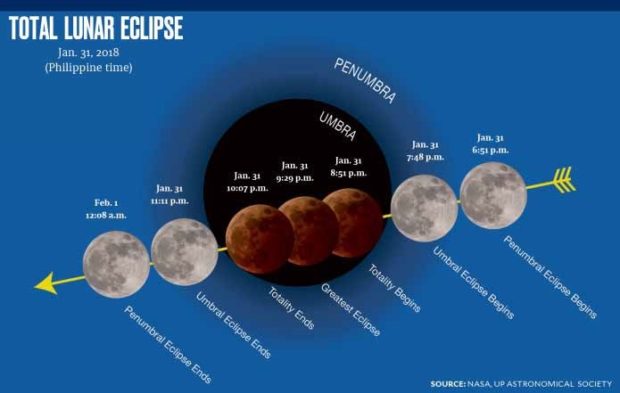Super blue blood moon: Pagasa says look eastward

Engineer Dario dela Cruz, chief of the agency’s space sciences and astronomy section, said an unobstructed horizon on the eastern side should give lunar lovers the best views for the astronomical trifecta.
The moon would start to turn yellowish as the lunar eclipse begins at 6:49 p.m., he said.
“The start of the [umbral eclipse] will be at 7:48 p.m. and at 8:51 p.m., the [Earth’s] shadow will totally block the moon,” Dela Cruz said in an interview.
No filters
Viewers will get a chance to see the copper-colored moon until 10:08 p.m., or a show lasting roughly an hour and 17 minutes.
Article continues after this advertisementDela Cruz said no special protection or filters for the eyes were needed, unlike when viewing solar eclipses.
Article continues after this advertisementStargazers, however, should hope for clearer skies, as the northeast monsoon and the tailend of the cold front were forecast to bring clouds with passing light rains, Pagasa said.
Dela Cruz, however, dispelled “omens” that some theorists link to the lunar event, such as natural disasters.
“Studies show that these three bodies (sun, Earth and moon) always align and it has not been proven that it causes earthquakes or volcanic eruptions,” he said.
Gravitational pull
But the super moon can cause the tides to rise by up to two inches, Dela Cruz said, as the gravitational pull becomes stronger with the moon coming closer to the Earth.
Director Renato Solidum, of the Philippine Institute of Volcanology and Seismology, also debunked theories circulating on social media that the super blue blood moon can trigger an eruption of Mayon volcano.
“As of now, Mayon is already erupting and the super moon has no effect on any hazardous eruption,” he said in an interview, adding that eruptions were based on the volcano’s gas content, not on gravitational pull.
Dela Cruz advised Filipinos to look up the sky tonight, since the next super blue blood moon would appear in 2037.
“It might take about 20 years before it happens again, so we should try to see it this time,” he said.